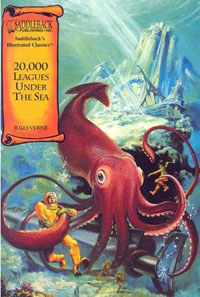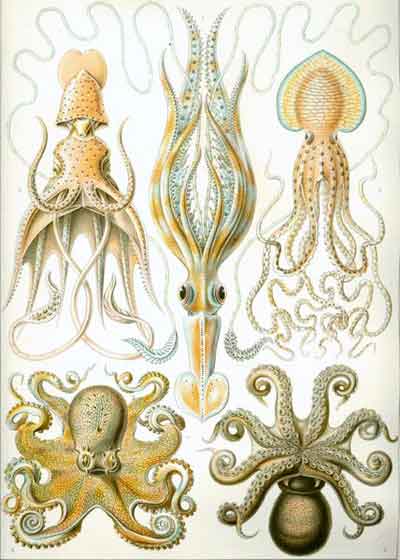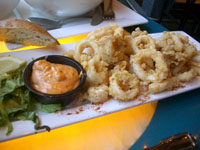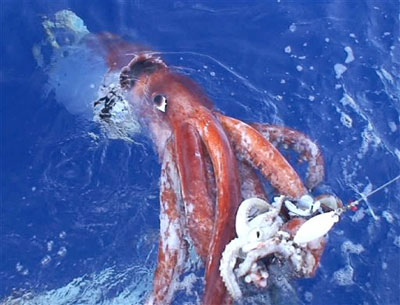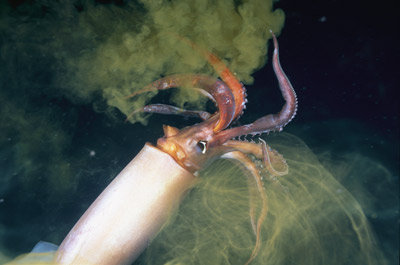 Brian J. Skerry/National Geographic/Getty Images
With angry eye and a cloud of ink, a jumbo squid flees from a diver.
Brian J. Skerry/National Geographic/Getty Images
With angry eye and a cloud of ink, a jumbo squid flees from a diver.
A squid's funnel acts like ajet engine, making them powerful swimmers. It draws water into its mantle cavity by expanding itsmuscles. The mantle stretches like a rubber band, then contracts and forcibly pushes the water out through the funnel. The squid shoots backward, tail first. When escaping from a predator, a squid can propel itself as quickly as 25 body lengths a second.
With their soft bodies, squid are vulnerable prey. They rely on their speed and agility, as well as their system ofcamouflage, for defense. Before a squid flees its predator, it releases a cloud of an inky substance calledsepia. This temporarily confuses the attacker, allowing the squid to escape.
融入他们的环境,鱿鱼thousands of pigment cells on their arms calledchromatophores, which are attached to tiny muscles. Chromatophores expand or contract to change the color or pattern of the squid's skin to match its background (these same cells also help squid attract a mate and communicate with other squid). Squid even can change the texture of their skin to simulate their surroundings by raising little flaps and bumps.
Squid are carnivorous and their favorite foods include small fish, crabs, shrimp and other squid. A squid will stalk its prey by hiding out of sight until the animal is within range, then shoots out its arms to ensnare the food. The squid then pulls the food to its mouth with its arms. It uses its sharp, parrot-like beak to tear off pieces, then the sharp radula on its tongue grinds up the food and pushes it down the squid's throat.
|
An Abundance of Calamari?
According to many scientists, global warmingis having a profound effect -- an often negative one -- on animal species. For squid, though, the phenomenon may actually be more of a blessing than a curse. Research has shown that the squid's digestive juices are more productive in warmer waters, and as a result, squid tend to grow larger and more plentiful as water temperatures rise. As evidence, fishermen off the coasts of New Zealand and Australia say they have been catching greater numbers of squid in recent years. Not all squid seem to benefit from global warming, though. Those that live in the colder depths may not be able to survive in balmier waters, scientists say. |
Squid reproduce sexually. A female can produce thousands of eggs, which she stores in her ovary. In male squid, sperm is produced in the testis and stored in a sac. When they mate, the male uses a special arm to transfer packets of his sperm into the female's mantle cavity or around her mouth, where the eggs are waiting. Then the female ejects the gelatinous mass of fertilized eggs from her funnel or mouth and hides them under rocks or in holes. After four to eight weeks, baby squid hatch. At birth, they are smaller versions of their parents. They feed on tiny creatures calledplanktonwhile they grow to adulthood.
Many squid live fast and die young -- their entire life cycle takes just one year. After male and female mate, they usually die. Less is known about the life cycles of deep-water squid, though, and they may have considerably longer life spans.
